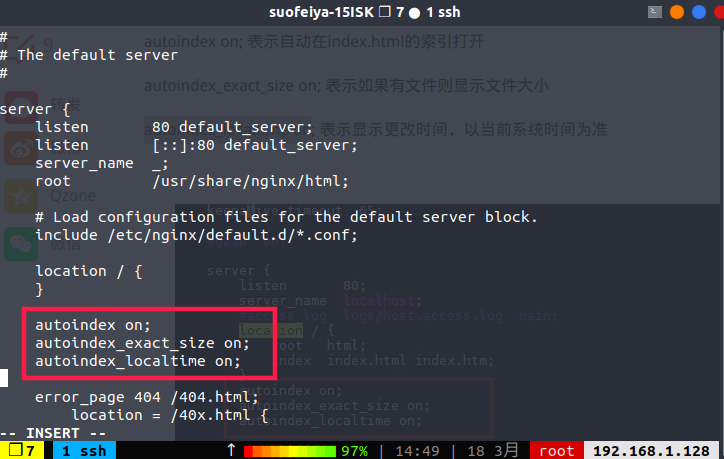搭建内网yum源,摆脱软件包困扰。
选择合适稳定的公网yum仓库
建议选择对运营商网络友好的yum仓库
国内可供选择的有:
- 阿里云:http://mirrors.aliyun.com/ (这里我使用阿里云)
- 网易:http://mirrors.163.com/
更多国内镜像仓库参考:https://blog.csdn.net/wyqwilliam/article/details/90581159
安装nginx并修改配置文件
为了方便起见,我这里使用yum仓库进行安装.
1
2
3
4
5
6
7
8
9
| [root@centos-7 ~]# yum install nginx -y
[root@centos-7 ~]# vi /etc/nginx/conf.d/default.conf
# -----在server段添加以下内容
# 自动在index.html的索引打开
autoindex on;
# 如果有文件则显示文件大小
autoindex_exact_size on;
# 显示更改时间,以当前系统时间为准
autoindex_localtime on
|
具体位置在下面这个位置
 启动nginx,使用
启动nginx,使用service nignx start 即可
创建自定义index.html文件
修改默认index.html为以下内容:
1
2
3
4
5
6
7
8
9
| <p style="font-weight:bolder;color:green;font-size:30px;">ALL of the packages in the below:</p>
<br/>
<a href="http://192.168.1.128/CentOS-YUM/Aliyun">Aliyun</a><br/>
These packagers from of CentOS ISO.<br/>
<a href="http://192.168.1.128/CentOS7-aliyun">CentOS</a><br/>
These packagers from of "Internet service provider".<br/>
<p style="font-weight:bolder;color:red;font-size:18px;">Please replace the file and fill in the following content:</p>
<p style="font-weight:bolder;color:blue;font-size:15px;">Way: /etc/yum.repos.d/CentOS-Base.repo</p>
|
在站点目录中创建CentOS-YUM/Aliyun(本地ISO文件仓库)和CentOS7-aliyun目录
添加并同步阿里云yum源
添加阿里云CentOS7 yum源
1
2
| # 注意备份原仓库源
curl -o /etc/yum.repos.d/CentOS-Base.repo http://mirrors.aliyun.com/repo/Centos-7.repo
|
同步阿里云CentOS7 yum源到之前创建好的目录当中,使用命令reposync -p /usr/share/nginx/html/CentOS7-aliyun
接着,使用createrepo -p /usr/share/nginx/html/CentOS7-aliyun来创建repodata文件
客户端配置
使用以下命令为客户端添加内网仓库地址
1
2
| yum-config-manager --add-repo="http://192.168.1.128/CentOS7-aliyun/base/Packages"
yum makecache # 更新缓存
|
在yum仓库服务器端创建定时任务
新建shell更新脚本update-aliyun.sh,内容如下:
1
2
| #!/bin/bash
/usr/bin/reposync -np /usr/share/nginx/html/CentOS7-aliyun
|
使用chmod +x update-aliyun.sh为其添加执行权限
添加定时任务(每5min执行一次)
1
| 5 * * * * root run-parts /root/update-aliyun.sh
|
其中run-parts的意思是执行后面目录中的脚本。
使用ftp搭建yum本地和远程仓库
以下仅记录关键命令:
1
2
3
4
5
6
7
8
9
10
11
12
13
14
15
16
17
18
19
20
21
22
23
| $ yum install vsftpd
$ systemctl start vsftpd && systemctl enable vsftpd
# 开启yum缓存功能
$ vim /etc/yum.conf
[main] cachedir=/var/cache/yum/$basearch/$releasever
keepcache=1
# 清除缓存
$ yum clean all
# 设置基础光盘base源
$ mkdir /var/ftp/centos7-base
$ mount /dev/cdrom /mnt
$ cp -arp /mnt/Packages/*.rpm /var/ftp/centos7-base
# 提供第三方镜像源
$ cd /var/ftp
# 同步中科大的nginx源到以上目录
$ rsync -avzP rsync://rsync.mirrors.ustc.edu.cn/repo/nginx ./
# 安装createrepo工具并创建repodata仓库
$ yum install -y createrepo
# 生成repodata
$ createrepo ./
|
需要注意的一点是:如果仓库中新增软件,需要重新生成repodata,也可以通过触发脚本实现。
客户端添加远程yum仓库:
1
2
3
4
5
6
7
8
9
| $ yum-config-manager --add-repo="ftp://YOUR_SERVER_IP/centos7-base"
$ yum-config-manager --add-repo="ftp://YOUR_SERVER_IP/nginx"
# 当然你也可以手动创建配置文件指定远程仓库
$ vim /etc/yum.repos.d/centos7-base.repo
[centos7-base]
name=centos 7 base
baseurl=ftp://YOUR_SERVER_IP/centos7-base
enabled=1
gpgcheck=0
|
附录:rpm和yum常用命令
rpm常用命令:
1
2
3
4
5
6
7
8
9
10
11
12
13
14
15
16
17
18
19
| rpm -q # 查看指定软件包是否安装
rpm -qa # 查看系统中已安装的所有RPM软件包列表
rpm -qi # 查看指定软件的详细信息
rpm -ql # 查询指定软件包所安装的目录、文件列表
rpm -qc # 查询指定软件包的配置文件
rpm -qd # 查询指定软件包的帮助文档
rpm -qf # 查询文件或目录属于哪个RPM软件
rpm -q --scripts # 查询rpm包安装前和安装后执行的脚本
# 查询未安装的软件包信息
rpm -qip # 查询未安装的rpm包详细信息
rpm -qlp # 查询未安装的软件包会产生哪些文件
# rpm 软件包升级
rpm -Uvh # 如果老版本不存在,则全新安装
rpm -fvh # 老版本必须存在
# 卸载软件包
rpm -e
|
yum常用命令:
1
2
3
4
5
6
7
8
9
10
11
12
13
14
15
| # 在线查询软件包
yum provides zip
yum provides */ifconfig
yum check-update # 检查更新
yum clean package # 只清除软件包缓存
# yum历史命令
# 查看历史执行yum命令
yum history
# 查询历史执行yum命令ID详细信息
yum history info N
# 撤销历史执行过的yum命令
yum history undo N
|
 启动nginx,使用
启动nginx,使用